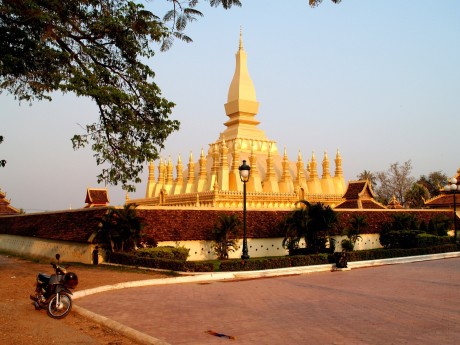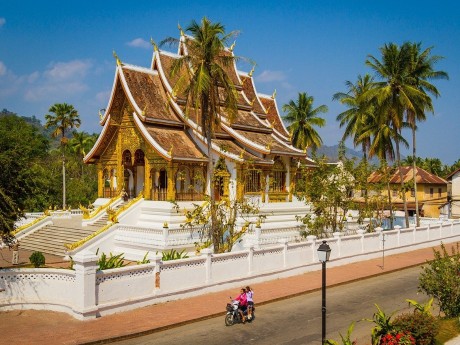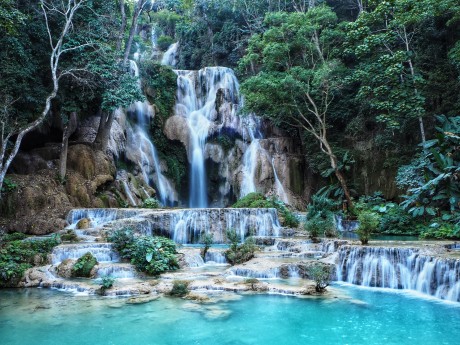Laos: Vientiane & Luang Prabang
Embark on an exquisite expedition through the untouched beauty of Laos, uncovering its serene landscapes and cultural treasures. Your first stop is Vientiane, the capital of Laos, where traditional charm meets modern influences. Discover the remarkable Patuxai Victory Monument offering panoramic views of the city from its summit. Delve into spirituality at Pha That Luang and explore the beauty of Wat Sisaket, marvelling at thousands of miniature Buddha statues, each with its own unique charm.
Read more
Embark on an exquisite expedition through the untouched beauty of Laos, uncovering its serene landscapes and cultural treasures. Your first stop is Vientiane, the capital of Laos, where traditional charm meets modern influences. Discover the remarkable Patuxai Victory Monument offering panoramic views of the city from its summit. Delve into spirituality at Pha That Luang and explore the beauty of Wat Sisaket, marvelling at thousands of miniature Buddha statues, each with its own unique charm. Unwind by the Mekong River, observing the transformation of Vientiane's riverside promenade. Head to Luang Prabang, a UNESCO World Heritage city between the Mekong and Namkhan Rivers. Take an early morning visit to witness the solemn Alms Giving Ceremony. Explore the revered Wat Xieng Thong, a stunning temple adorned with intricate mosaics and ornate architecture. Indulge your sense of adventure at the enchanting Kuang Si Waterfalls. Surrounded by lush greenery, swim beneath cascading waters in turquoise pools. End your day atop Phousi Hill, catching the sunset over the city and its stunning surroundings. Waterviews strives to offer accommodation options within walking distance of water and/or in an area of touristic interest. Our prices include taxes (but excludes local tourist taxes). Customize your trip to your personal preferences with optional activities (hit the “Add Activities’’) or change hotels, etc. Contact us for customization at no extra cost at: Service@waterviews.com
Destinations
- Vientiane
- Luang Prabang
Itinerary
Vientiane

Vientiane, also known as the ‘Sandalwood City’ of Laos, is a sprawling colonial city set on the banks of the Mekong River. Although locals consider it busy in comparison to the country’s other destinations, Vientiane offers a laid-back and serene atmosphere compared to other major Southeast Asian cities. Originally founded in the 10th century, the city is now Laos’ capital and offers a wide variety of attractions such as historical temples and shrines as well as a collection of French colonial architecture.
Read more
Vientiane, also known as the ‘Sandalwood City’ of Laos, is a sprawling colonial city set on the banks of the Mekong River. Although locals consider it busy in comparison to the country’s other destinations, Vientiane offers a laid-back and serene atmosphere compared to other major Southeast Asian cities. Originally founded in the 10th century, the city is now Laos’ capital and offers a wide variety of attractions such as historical temples and shrines as well as a collection of French colonial architecture.
Additional Information
Compared to the hectic, bustling capitals in other Southeast Asian countries, Vientiane's relaxing atmosphere makes it feel like the small town it is. After you've done the round of temples, the best thing to do here has always been to wander down to the riverside, relax with a cold Beerlao, the Lao national beer, and watch the sun set on the Mekong.
Of course, the booming tourism industry is changing this by slowly but surely bringing the excesses of Thailand and China to this formerly sleepy city. Just like any other Southeast Asian capital or major city, Vientiane is experiencing a building boom. Even its Presidential Palace is having a major makeover-addition and a new convention centre has been built.
History
Settled since at least 1000 CE, Vientiane became an important administrative city of the Kingdom of Lan Xang ("million elephants") in 1545. Ransacked in 1828 by the Siamese, Vientiane sprung back to be again named the capital of the protectorate of Laos by the French, a position it kept after independence (1953) and after the communists took over in 1975. Today Vientiane is the largest city in Laos, with an estimated population of 210,000 in the city and some 700,000 in Vientiane Prefecture.
Orientation
Vientiane stretches along the northeast bank of a bend in the Mekong River. From the riverbank inland, the main roads running parallel to the river are Fa Ngum Rd, Setthathirat Rd, and Samsenthai Rd. The central district, Chanthabuli, contains most of Vientiane's governmental offices, hotels, and restaurants. Vientiane's widest boulevard, Lane Xang Rd, runs from the Presidential Palace (now used for governmental offices and for state receptions) to the northeast around Patuxai, the Victory Gate, towards Pha That Luang, the That Luang Stupa, the most important religious monument in Laos.
© Sourced from Wikivoyage
Luang Prabang

Luang Prabang was Laos’ royal capital until the mid-16th century, and today retains an air of old-world charm and tranquillity. Graced by its faded French colonial legacy, the city features gloriously gilded temples combined with a myriad of ancient streets and hidden alleyways that create a unique medley of bygone eastern and western culture. Luang Prabang also boasts UNESCO World Heritage Site status, and is a must-see on any itinerary of the country.
Read more
Luang Prabang was Laos’ royal capital until the mid-16th century, and today retains an air of old-world charm and tranquillity. Graced by its faded French colonial legacy, the city features gloriously gilded temples combined with a myriad of ancient streets and hidden alleyways that create a unique medley of bygone eastern and western culture. Luang Prabang also boasts UNESCO World Heritage Site status, and is a must-see on any itinerary of the country.
Additional Information
Set at the confluence of two rivers that almost surround the town, and beneath a temple-topped hill, Luang Prabang is a wonderful patchwork of traditional Lao wooden houses and hints of European architecture, reminders of when Laos was part of the French colony of Indochine. Golden-roofed wats (temples), decorated with mosaics and murals of the life of Buddha, sit under the gaze of wrap-around teak balconies and 19th-century shuttered windows. All of this is set against a backdrop of verdant greenery and rugged mountains.
Luang Prabang is a relatively small city with an atmospheric and charming personality. With UNESCO so closely involved and a largely responsible group of local business owners, the pressures of mass tourism have been held at bay, but for how much longer remains to be seen. Restaurants in the main street cater for luxury tourists. More typical Lao venues can still be found along the Mekong.
History
Luang Prabang rose to prominence as the capital of the first Lao kingdom (Lan Xang, land of the million elephants) from 1353. The city owes its present name to the Pha Bang, a revered Buddha image (now in the Royal Palace Museum) which was brought to the city by King Visoun during the golden age of Lan Xang in the early 1500s.
The fragmentation of the Lao kingdom at the end of the 16th century left Luang Prabang a militarily weak independent city state paying tribute to surrounding kingdoms. The 1887 sacking of the city by the Chinese Haw led the Luang Prabang monarchy to accept the protection of the French, whose influence led to the construction of the many fine colonial villas that sit harmoniously alongside traditional Lao architecture.
The city fell into decline in the latter half of the 20th century following the reluctant withdrawal of the French, and the 1975 revolution which brought an end to the Luang Prabang monarchy. The relative poverty of newly-independent Laos perhaps helped save Luang Prabang from the ravages of 20th-century city planning.
The reopening of Laos to tourism in 1989 resulted in a remarkable turnaround in the city's fortunes, as crumbling timber houses and colonial mansions were sensitively restored and transformed into immaculate guesthouses and boutique hotels. In 1995 the city was placed on the UNESCO World Heritage List.
© Sourced from Wikivoyage





